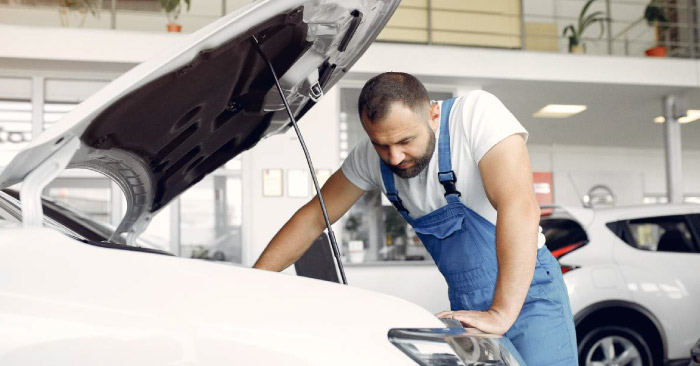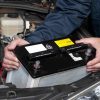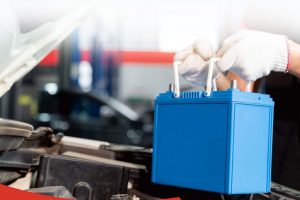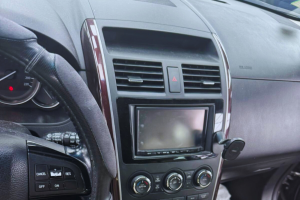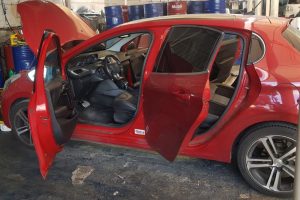Whether you just got a car or have been driving one for long, following certain car maintenance tips can help your car be at its best. If you need some guidance or a checklist of tips for your car to be in its optimal condition, this is a useful read.
Here’s a comprehensive list of car maintenance tips and checklists for every car owner
-
Inspect your vehicle regularly
Take a walk around your vehicle at least once every week. While you take a walk, inspect your car and look for body damage. You should also inspect your tyres for any wear, punctures or cuts and test every lock, window and even the sunroof.
-
Check your air filter
A lot of car problems arise when your air filters are clogged or if they fit loosely. Air filters block dust, pollen and other contaminants to keep your engine healthy. But when dirty, the air filter can reduce the airflow into the engine, robbing your vehicle of power, reducing performance and fuel economy. It’s recommended that you replace your air filter every 12,000 miles.
-
Check your tyre pressure regularly
Tyre pressure can impact the fuel economy. It also affects the comfort and handling. Your car’s owner manual will have the recommended tyre pressure mentioned on the owner’s manual. Generally, the tyres pressure check should be done every week.
-
Clean your engine’s exterior
It’s equally important to clean your car’s exterior engine as much as it’s important to keep the interior engine clean. If not cleaned properly, even minor debris in the wrong place can do damage to your engine. For example, while checking your brake fluid, some grease might fall into it. Due to this, there can be damage to the brake. Thus, ensure you check your brake fluid levels at least once every month.
-
Protect your headlights
Turn on your headlights once a month when you park in front of a flat surface to check if both headlights are working properly and well-positioned. Visually inspect both turn signals by walking around your car and see and your parking lights. You can even ask a friend to stand behind the car while you engage the brakes to be certain that your brake lights are functional.
-
Check your battery
Your car battery is one of the most important components required for it to run. The car’s battery is responsible for providing a large amount of electrical current for the starter, engine and other electronic accessories in the vehicle. Extreme temperatures affect the performance of the battery so regular battery testing will ensure that the battery will perform when you need it to.
-
Change your spark plugs
Spark plugs could affect the efficiency of your car’s engine. They’re responsible for igniting the gas and air mixture that ultimately powers your vehicle. Thus, when the spark plugs don’t function properly, it causes the engine to lose power and it won’t function at its optimal capacity. So get a professional to check your spark plugs so that those plugs are replaced if faulty.
-
Get your tyres rotated and balanced
Tyre rotation is important to maintain the safety and performance of your vehicle. It gives your vehicle a quicker steering response and a smoother ride of course. Rotating your tyres gives them a chance to even out their wear and helps extend the life of the tyres. Ensure that you check the tyre pressure of your car once every month and even before you take long trips or when you carry an extra load in your car. Your car’s manual will tell you how much air pressure the car tyres require.
-
Ensure your cooling system works
Your car’s cooling system and radiator need to be clean to work efficiently and effectively. Your car’s radiator builds up a deposit with normal wear and tear, which can disrupt the cooling system. With a radiator flush, you can keep your cooling system in shape quickly and inexpensively. You can take a look at your car’s manual to find out if you need to flush the radiator once a year or after every two years.
-
Know the meaning of different warning light indicators
Almost all cars have elaborate systems of sensors and warning lights that tell you everything from whether you forgot to replace the gas cap to the fact that one of your tyres is low on air. Learn what each of your car’s warning lights means and how to fix it. Your owner’s manual can be of great help here. If any light flashes and you can’t immediately pinpoint and fix the problem, take your vehicle to a trusted mechanic right away.
-
Clean the brake dust off your wheels
The brake dust on your car doesn’t affect the full functioning of your brake but it does make wheels a little unpleasant to look at. When you apply the brake, a mix of materials that come in contact from the brake rotor and brake pad which is the brake dust. 92% of the dust is iron. The remaining 8% will be grime, dirt, carbon content and other particles. If these are exposed to the sun along with your wheels, they can leave severe stains on your wheel. So, it is important to clean the dust off your wheels and with a damp sponge. As dust typically clings to your wheels via static electricity, you’ll also require cold water.
-
Protect your car interiors
Avoid eating food inside your car as much as possible. A good way is to cover surfaces as much as possible. Keep floor mats, which will keep you from tracking in mud or dirt and grinding it into the carpets with your feet. Add seat covers, which can protect your car seat’s upholstery. Cover can also help aid your posture and even help customize the look of your car. Make it a point to vacuum the car regularly. If you live in a hot region ensure that you keep your windows slightly open. The hot air inside your car has the potential to dry and damage your car’s interiors if it can’t come out.
-
Check drive belts
Your engine produces power so that other parts and accessories run including the power that your vehicle requires to run. The drive belts shift the power from your cram or crankshaft to the car’s alternator, air conditioning compressor, power steering pump, air pump, water pump and any other device that relies on mechanical power. Modern cars use a single belt which is also called a serpentine belt to connect and rotate from the crank pulley. As these belts are typically made of rubber or other polymers, they wear a lot even with normal use. So it’s important to check these belts regularly to inspect for visible hairline cracks or any change in their integrity. You’ll need to look at the integrity of both your serpentine belt or V-belt and your timing belt unless your engine is chain driven.
-
Check oil levels
There are a lot of mechanical moving parts in your car’s engine that creates friction as they brush against each other. This friction generates heat and can lead to a significant reduction in engine performance. This is why minimizing if not eliminating friction from these parts is crucial to ensure smooth operation. Else, you might hear loud noises from your engine and a substantial reduction in fuel economy can occur. Check your engine’s oil level as an integral part of your basic car maintenance routine. It’s also critical to look at the color of the oil. It shouldn’t be black. The dark color usually indicates the presence of contaminants, excessive heat, the addition of chemical additives or even worse, sludge. Your owner’s manual tells you the frequency of oil change. You’ll also need to check the correct viscosity grade for your car and the environment upon which it normally operates.
-
Drive better
Your way of driving reflects the condition of your car. If you’re hard on your car and have a habit of fast takeoff, quick braking, sharp quick turns, riding over bumps at high speeds, hard shifting, etc. then your car will wear faster and there can be damage. When you drive smartly and safely, there’s not only less wear and tear on your car but you also can save on fuel costs. So start today by taking a look at your acceleration and braking habits. If you’ve got a habit of taking off quickly and applying brakes suddenly, then remember that each smooth transition saves money on gas. When you drive below the speed limit and avoid sudden stops, it will help you stay safer, save money, and help your car last longer.
-
Carry automotive tools at all times
A good tip is to carry some basic tools, so you can use them to maintain your car on the go and work with those tools in case your car faces different problems. For example, if you delay fixing a leak, it can cause potential damage to your engine. Either you’ll need to get your car towed or use your tools to work on the problem. After that, driving might not be an option. A few tools that can be helpful are thick gloves, heat resistant waterproof silicone tape, electrical tape, wire cutters, screwdrivers, tongue and groove pliers, a flashlight and a knife. You can carry a tool kit.
A set of tools can come handy and will give you choices that you wouldn’t have otherwise. They’ll be useful in other situations as well. -
Keep your car covered
Keeping your car away from the reach of sunlight, trees and birds can help your car’s paint and interior remain in good condition. Extreme weather, harmful radiation and nature can take a toll on your vehicle. You might wash your car regularly and use a protectant on plastic and rubber parts but a car cover is important too. It will keep your car looking its best for years to come so a car cover is a good investment. So keep your car covered when not in use and try to keep it in your garage.
-
Clean your windshield and replace the wipers
A dirty windshield will not let you see clearly and thus create inconvenience. They can cause visual impairments if not cleaned regularly and can result in accidents at times. For safe driving, the driver must have a clear view of the road. If you don’t clean those windshields, the dirt and particles will accumulate and can scratch the windshield when you use the wipers.Check your wipers when the rainy season is approaching and get them replaced if needed. Your car’s glass can get scratches and obstruct your view if you use damaged wipers and it might lead to the need to replace your entire windshield.
-
Inspect your fluids regularly
Get into the habit of checking car fluids along with the tyres. When the engine cools down, open the hood and remove the oil dipstick. Clean the dipstick thoroughly and put it back again. When you pull it out now, you’ll notice the oil is up to a certain level. Check and see whether the oil is at the correct level. Also, replace the oil at regular periods. While doing so, also check the fluid level of your power steering, the hoses and belts for any signs of wear. Also, check the transmission fluid level after warming up your car.
Get your tyres and fluids regularly inspected for the best performance of your car. -
Check engine coolant level
While there’s oil in your engine to help reduce the friction between moving parts and help it prevent from getting heated at a much faster rate, your engine will also need a system that will help it get rid of this generated heat. That’s where the function of your radiator is required and the fluid supplied to it is your engine coolant. If the coolant in the reservoir is running low or if it’s not there, then heat from the engine won’t get dissipated into the environment. This can lead to your car’s engine to overheat. Before you start rolling out of your driveway, you need to check your engine coolant levels as a part of your car maintenance checklist. Today, most cars possess coolant reservoirs that are somehow translucent and have appropriate level markings on the panel. Without even opening the lid of the reservoir, you should be able to visually inspect whether it’s running low or not. Read your car manual to look for the engine coolant reservoir in your car.
-
Wax your vehicle
Waxing your vehicle every six months after car washing will not just keep it shiny but also help reduce the chance of rust and keep the paint in good condition. Irritants such as dust, sand, and salt can build up and environmental factors like ozone and ultraviolet light can cause microscopic damage. But waxing can help extend your paint’s life and minimize this by forming a protective seal.
-
Only use superior detailing supplies
Using the right kind of supplies and detailing tools for your car makes it look like it just got out of the showroom. It also helps provide a protective barrier against the elements and keeps it shining like new. The key is to use superior quality car detailing products.
-
Don’t touch the glass bulbs when repairing
Make sure you only touch the metal bulb holder located at the bottom of the lighting fixture whenever you have to replace the bulb on your headlight. If you have to touch the glass, you can wear clean mechanic’s gloves or use sterile surgical gloves. These gloves will help prevent the transfer of oils, grime, dust and dirt from your fingertips to the specialized coating that’s there on the bulb’s exterior surface. The dust particles, grease or oil can affect the special coating present in the bulb’s surface. So when you turn your headlights on, the part of the bulb with dust will heat up a lot faster than the rest of the bulb and cause the bulb to crack.
-
Replace your car’s cabin air filter
If you’ve got a family member who’s quite allergic to dust and other airborne particles then you might want to replace the cabin air filter of your car. It’s one of the easiest ways to keep everyone safe and comfortable inside your car’s cabin. It’s recommended to replace your cabin air filter after every 12 months or 12,000 miles whichever comes first. You can refer to the owner’s manual to know the recommended schedule of air filter replacement.
-
Check your AC’s refrigerant level
Before starting any A/C related task, it’s important to know what refrigerant you need. It’s important for the air conditioner to have a proper level of refrigerant which is the cooling agent that keeps your vehicle running efficiently. If your car’s air conditioner isn’t blowing cold air or there’s a clicking noise coming from the engine then most likely the unit needs to be recharged. A properly working AC will not only make a vehicle’s occupants more comfortable and it’s also a good maintenance tip to follow.
-
Take it to the experts
Although there are some things that you can fix in your car yourself, there are times when the car’s condition demands professional expertise. So at times like these, take your car to an authorized car service provider without any delay. It’s a good practice to keep the receipts from any repair service. When you sell the vehicle, accurate maintenance records can increase the value of your car to potential buyers. So when it comes to car maintenance, things aren’t very difficult. Your car just needs to be taken care of the right way so that its life gets extended. Moreover, you get a higher resale value for its condition. After all your car is your favorite travel companion, isn’t it?
